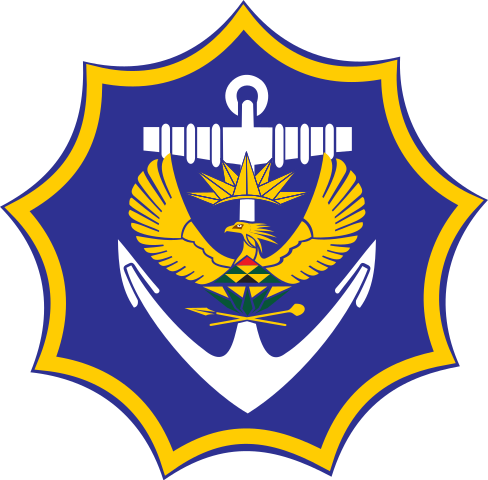 Foreword: Since it’s official creation in 1922, the SAF (South African Navy, with “Defense” added more recently) always possessed a strategic role by its location, an obligatory passage between the Atlantic and Indian Ocean and at large, Asia. This was showcased between the construction of the Suez canal (inaugurated 1869) and demonstrated again during its closure from October 1956 until March 1957, and moreover at the beginning of the Six-Day War and for eight years, from 5 June 1967, up to 5 June 1975, which obliged the construction of supertankers needed to round the cape to Asia and Back, as most of the merchant traffic. A situation, given the always volatile context in the middle east, that might repeat in the future.
Foreword: Since it’s official creation in 1922, the SAF (South African Navy, with “Defense” added more recently) always possessed a strategic role by its location, an obligatory passage between the Atlantic and Indian Ocean and at large, Asia. This was showcased between the construction of the Suez canal (inaugurated 1869) and demonstrated again during its closure from October 1956 until March 1957, and moreover at the beginning of the Six-Day War and for eight years, from 5 June 1967, up to 5 June 1975, which obliged the construction of supertankers needed to round the cape to Asia and Back, as most of the merchant traffic. A situation, given the always volatile context in the middle east, that might repeat in the future.
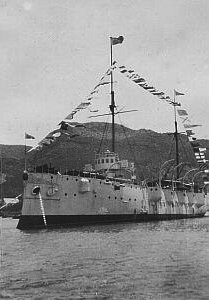 From humble beginnings in WW2 (sporting a few armed trawler for ASW patrols), the The South African Navy grew to a sizeable green water navy, operating ASW Frigates and conventional submarines, plus missile-armed, state of the art fast attack crafts for closer defense in the 1980s despite a relative international isolation. Although non-aligned on NATO or any other western organization, its de facto fight against communism in the region (notably Angola) had its position secured with the Western powers in case of open conflict with USSR. In case of war, the high seas Pacific fleet could have seen her access potentially blocked in Suez (Egypt was declared non-aligned) and forced to round the coast of Africa to reach the Atlantic, other soviet fleet accesses being blocked by the Skagerrak (Baltic fleet) or the Dardanelles (Black sea fleet) and the northern fleet by ice in winter.
From humble beginnings in WW2 (sporting a few armed trawler for ASW patrols), the The South African Navy grew to a sizeable green water navy, operating ASW Frigates and conventional submarines, plus missile-armed, state of the art fast attack crafts for closer defense in the 1980s despite a relative international isolation. Although non-aligned on NATO or any other western organization, its de facto fight against communism in the region (notably Angola) had its position secured with the Western powers in case of open conflict with USSR. In case of war, the high seas Pacific fleet could have seen her access potentially blocked in Suez (Egypt was declared non-aligned) and forced to round the coast of Africa to reach the Atlantic, other soviet fleet accesses being blocked by the Skagerrak (Baltic fleet) or the Dardanelles (Black sea fleet) and the northern fleet by ice in winter.
From naval volunteers to a united force to 1922
Although the Suez Canal (inaugurated in 1869) made the cornering of Africa less common for shipping to access the Indian Ocean and Asia, South Africa still was a valuable operating base in the south, enabling control of the Western Indian Ocean (And thus access to India, pearl of the Empire) and east african colonies as well, as they were developed in the 1880-90s.
Thus, the Royal Navy secured British presence of South Africa, which started with the VOC “Cape Colony”, enabling primarily Dutch settlers to the interior, and after the 1795 Battle of Muizenberg, British presence was enacted, conceding the Batavia Republic and final full possession in the Anglo-Dutch Treaty of 1814. Self-gverning, the colony grew gradually in the XIXth century and became the “Cape Province”, then in 1910, the Union of South Africa, uniting three other colonies, ultilately renamed the Province of the Cape of Good Hope, was still not a sovereign state before 1931. Thus there was no independent naval force, and the Royal Navy presence was permanent.
It is generally agreed that the South African Navy was the result of two early entities outside the Royal Navy, the Natal Naval Volunteers (NNV) formed in Durban on 30 April 1885 and the Cape Naval Volunteers (CNV) formed in Cape Town in 1905. They used civilian vessels which acted as fishery protection patrol boats. On 1 July 1913 these two units were amalgamated as the South African Division of the Royal Naval Volunteer Reserve (RNVR). Meanwhile, since the 1880s a large variety of Royal Navy ships transited at Durban and Cape Town, and after the Boer war, resided permanently.
Articles
Wager class destroyers (1950)
President class Frigates (1956)
Maria Van Riebeeck class subs (1969)
Astrant class subs (1977)
Minister class FAC(M) (1977)
SANDF Minesweepers
Origins
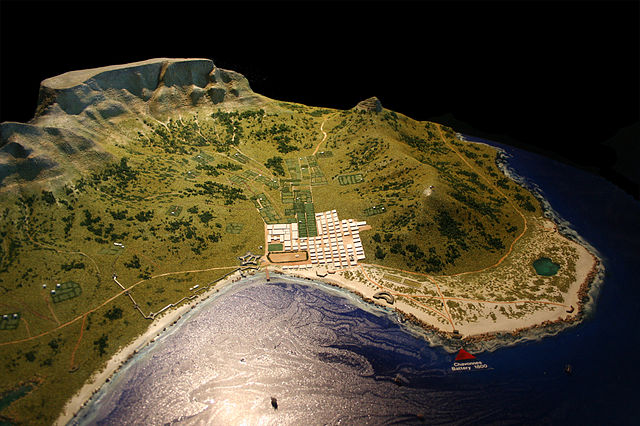
Cape Town in 1800 (model) – CC
The African Union (of Cape Colony, Natal, the Transvaal and the Orange Free State amalgamation, 31 May 1910) saw the creation, under British supervision and approval, of the South African Naval Service (SANS) in 1912. The country’s naval defence however was however still integrated within the Royal Navy and had no dedicated ship so far. The next year, two new Australian warships, the battlecruiser HMAS Australia light cruiser HMAS Sydney transited via South Africa to Australia and visited Cape Town and Simonstown on 26–29 August and later visited Durban on 31 August–6 September. They were the first major warships to be seen here. but this was only the beginning:
When the first world war broke out, 164 members of the RNVR joined the Royal Navy on various ships. In all 412 South Africans would serve with the RNVR and the naval base at Simon’s Town was developed to serve as an improvized instruction school, arsenal, and small drydock, playing a strategic role for the entente in this area. The volunteers manned ships patrolling South Africa’s coasts against German surface raiders, also clearing up mines laid by the surface raider SMS Wolf. However as the war ended but the RNVR had still no dedicated ships.
Creation of the South African Navy (SAN) in 1922
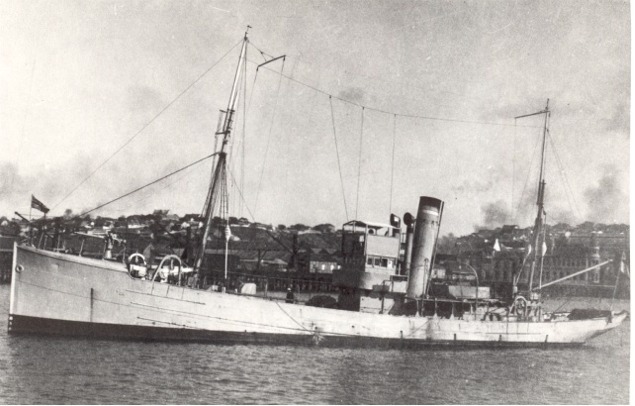
HMSAS Immortelle, patrol armed trawler
In 1922 this force was consolidated -still without dedicated ships- as a new semi-independent entity called the SAN. At last, with a permanent loan from the Royal Navy in 1922, HMSAS Protea, a hydrographic survey vessel was acquired. She was followed by HMSAS Sonneblom and HMSAS Immortelle, former minesweeping trawlers. However the Great Depression saw the metropolis cut down subsidies and the ships were handed back to the Royal Navy, starting with HMSAS Protea in 1933 and the remainder in 1934. This angered the former volunteers of SAN as in the meantime Australia’s Navy (RAN) was much more developed, with cruisers and destroyers and the Royal New Zealand Navy as well.
Meanwhile, the British Commonwealth was born from Imperial Conferences where Britain and its dominions acquiring equal status and the British Commonwealth of Nations was created in 1926, later formalised by the Statute of Westminster in 1931. Despite of this SAN was still undermanned and a underfunded and this state of affairs was still there when WW2 broke out. But the war change it dramatically.
The SAN role and expansion in WW2
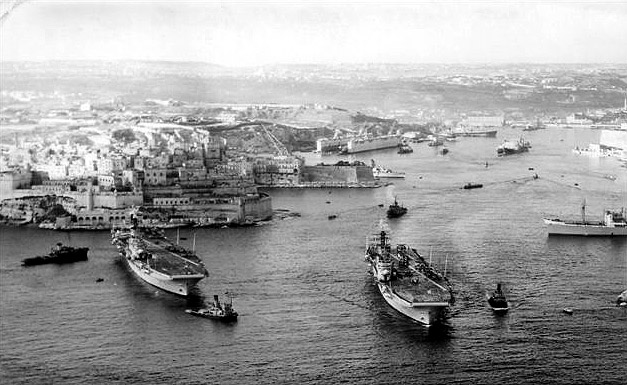
Simon’s Town in WW2 – src: https://www.simonstownboardwalk.co.za/
In 1939, SAN was just a nominal naval organisation with two commissioned officers and three ratings, no warships. Meanwhile German auxiliary cruisers were not inactive: Almost from the start they started to roam the trade links between the Empire and the Indian Ocean via South Africa, and in addition long-range U-Boats and minelayers started to seriously threaten the Cape sea route, soon joined by Italian submarines and from the east, Japanese submarines. That’s why the control of Madagascar after the fall of France became imperative (Operation Ironclad). A total of 133 merchant ships were sunk off the coast of South Africa.
By the same time, due to the lack of patrol ships, only three submarines were sunk. The SANS needed a quick expansion to play its role, moreover as volunteers would not be hard to find. Several minesweepers were acquired at first, plus small ASW vessels, converted trawlers or whale catchers. On 15 January 1940, SANS became the Seaward Defence Force (SDF). Its main responsibility was minesweeping activities off the South African coast and soon also anti-submarine patrols in coastal waters.
During the wars, the SAN operated two minesweeping trawlers and a survey ship; most of the seamen were South Africans while the Royal Navy provided the officers. From this very modest beginning, in a period when the RN’s South Atlantic Squadron, based at Simonstown, still shielded South Africa, the SANS expanded enormously during the Second World War, providing personnel for RN ships and manning armed trawlers and whalers for coastal patrol work.
From January 1941 however, some of these anti-submarine trawlers were sent in the Mediterranean, further depleting local forces. From 1st August 1942, both the SDF and RNVR(SA) were amalgamated and turned into the South African Naval Forces (SANF), trying to keep the strategic Cape sea route safe. Also in October 1943, the South African Women’s Auxiliary Naval Service (SWANS) was created, but segregation was instituted. Despite of this, many colored peoples (including numerous Indians) did serve as non-combatants on board SANF’s ‘little ships’ as cooks and deck hands. But the size of the Navy however stayed anecdotal compared to the expansion for example of the RCAN, which rose to the world’s fourth rank in 1945.
In 1944-45 the RN transferred three “Loch” class frigates, in addition to the two “River” class frigates and some eighty smaller craft in service, mostly armed trawlers. Note: A full poster and decicated page for the WW2 SANF will be published at a later date.
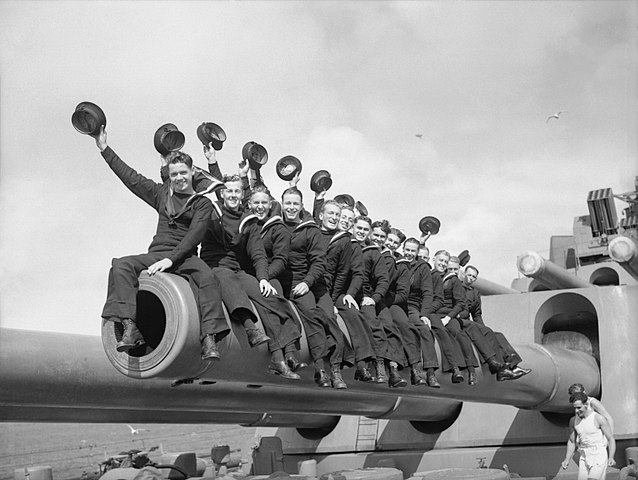
SANDF crews served on board many RN ships until 1945. Here, men of HMS Nelson
After the the war ended in the European theatre, two SANF ships were sent to the Far East. In total 2,937 South Africans served in the Royal Navy during in WW2, of whom 191 never returned. Small South African groups served on board many RN ships around the world and mixed with other Commonwealth naval personnel in the Pacific as well. Both Capetwon and Simonstown were largely expanded in their capabilities and allied ships transited her, kept in maintenance, supplied and repaired in their drydocks.
In 1944, two “River” class Frigates sent there were crewed with SANDF personal and passed under SANDF flag and command, and later they were joined by three former surplus “Loch” class frigates. They were the largest SANDF ships in service so far. In 1945, SANDF counted 8,000 personal, plus 3,000 which served with RN ships.
A far cry from other navies of the commonwealth, at least it gave the impression South Africa did its part in the war, whereas the press spoke more frequently of ground troops, sent despite the opposition of J.B.M. Hertzog, prime minister of South Africa and the leader of the pro-Afrikaner and anti-British National Party. Opposite was Field Marshal Jan Smuts, a confident of Churchill, which led four infantry divisions that fought well in North Africa and Italy, as did the South African Air Force (SAAF). South Africa also provided its own armour.
SANDF early cold war
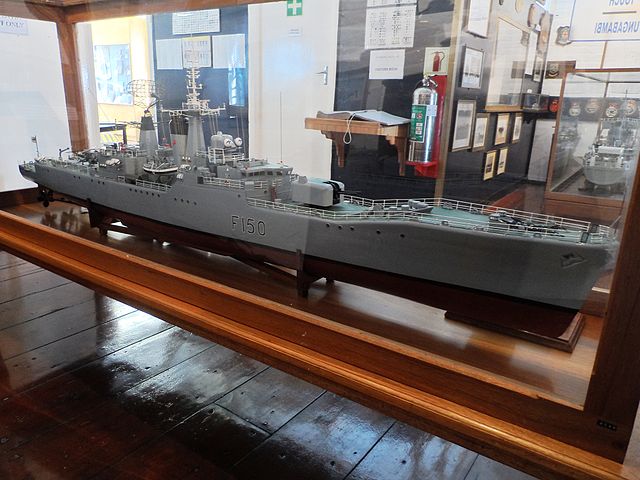
Pdt. Kruger at the SA Naval Museum (CC)
Personnel totalled over 8,000 by July 1945, and 3,000 more were serving in the RN. The South African Navy was officially founded in 1946, but with rapid demobilisation the new navy kept only the three Loch’ class frigates, a minelayer, eleven harbour defence motor launches and two boom defence vessels. The RN protection remained, but the Nationalist Party government elected in 1948 found itself increasingly at odds with Britain, and took steps to increase its independence in defence matters; to its navy, already strengthened by the acquisition of two fleet minesweepers in 1947, were added two destroyers in 1950-52 and two coastal minesweepers in 1954.
About the Simonstown Agreements
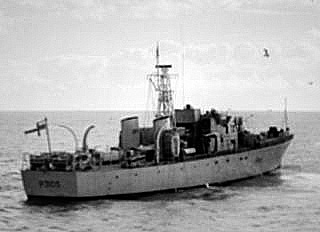
After WW2 ended, naval activities slackened off and after negotiations between the South African Minister of Defence, and the British Government, the Dockyard was handed over to the South African Navy in 1957. In 1967, Simon’s Town was proclaimed a “White Group Area” and over the next few years colored people, whose family ties sometimes went back to the very early days of the Town’s growth, were obliged to move away, original housing being in some cases bulldozed flat. In 1975 saw a number of changes with extension of the Dockyard area: A large area was reclaimed at Jaffa’s Beach, the harbor walls were extended further to the sea, making the actual, large “Tidal Basin”.
Under the 1955 Simonstown Agreement, Britain handed over her base to South Africa (1 April 1957) and the SAN was expanded to take responsibility for the Cape sea route. Six fast anti-submarine frigates (three conversions, later reduced to one, and three new construction), eight coastal minesweepers and four seaward defence boats would be purchased from Britain, as well as Blackburn Buccaneer strike aircraft and Avro Shackleton maritime patrol aircraft. Britain and her allies would in return be able to use the extensive fuelling, storage, repair and communications facilities at Simonstown, even in a war which did not involve South Africa. Joint training and exercises with the RN and attendance of naval personnel at courses in the UK kept the SAN up to date.
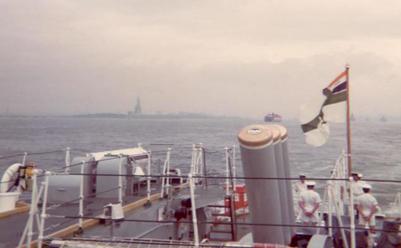
SAS President Kruger in New York, aft view showing the Limbo ASWRL (cc)
The 1961 and Apartheid policy rift
On becoming a republic in 1961, South Africa was compelled to leave the Commonwealth, the first stage towards her status of pariah among nations. Militarily, she increasingly began ‘looking to her moat’, but arms procurement became steadily harder; Britain first refused to provide submarines as offensive weapons, and then started making difficulties about defensive weapons, although supplying a survey ship in 1969. France, always alert to a profitable arms deal, was more accommodating, and three Daphne class boats were ordered from Dubigeon-Normandie. A new subnmmarine base was built at Simonstown, with an enclosed repair yard and a Synchrolift marine elevator, capable of lifting any South African warship except the replenishment ship SAS Tafelberg.
Gradual isolation and arms embargoes

Various naval ensigns of the SA Navy
The second half of the 1970s saw gradual international isolation and criticism, compounded by the 1973 UN label of Apartheid policy as a “Crime against Humanity”, magnified by brutal state repression and mass incarcerations after the Soweto uprising of 1976 and death of activist Steve Biko in 1977. The 1978 UN arms embargo was already loosely in place since 1962 but was not total and stricktly controlled. International economic disinvestment was also stepped up, aggravated by miltary expensed in the frame of regional foreign policy after the end of the Portuguese rule in Angola and Mozambique in 1975 and negotiated settlement in Ian Smith’s Rhodesia.
Although the Border War was mostly a land war in South West Africa’s northern border (modern day Namibia) and Angola, the Navy readjusted its previous organisation while P. W. Botha obtained contacts with Israel, also embargo-struck, and ordered nine “Reshef”—Warrior-class FACs in 1974. Procurement of two new Type-69A light frigates and two Agosta-class submarines from France were cancelled however.
Indeed, the 1974 Simonstown Agreement saw its abrogation by the British Labour Government, giving up base facilities and ending all naval operations. The two Agosta class submarines and two type A 69 corvettes ordered in France in 1975-76 under international pressure and the 1977 mandatory UN arms embargo prevented their delivery. They were sold to Pakistan and Argentina respectively.
Naval personnel reached 6758 (including 1574 two-year conscripts) by 1981 (plus 10,000 reservists), a notable increase on the figures of 2370 in 1960 and 3440 in 1970. A Marine Corps was formed for harbour defence in July 1979 but was disbanded in 1990. The Advokaat radar system scans the republic’s 2100 nautical mile coasts and monitors 600,000 tons of shipping passing the Cape every day. The principal naval base is Simonstown and forces have been withdrawn from Durban as an economy measure.
1980s border war’s naval side
In 1987, South Africa commissioned the locally designed and built Fleet Replenishment ship SAS Drakensberg, from Durban. It was a success of this policy, alongside the domestic Centurion-based Olifant MBT. It remains the largest and most sophisticated warship built in South Africa and was followed three years after SAS Tafelberg. This ship could deploy a company strength landing force with six landing craft, two medium helicopters and having a small hospital.
At the same time, the Border War saw a great deal of coastal protection frop the Navy. From 1976 to 1989, the South African Navy maintained sea control around Southern Africa, while supported land operations in some occasions. But by the end of the 1980s the Navy was drastically reduced notably for its anti-submarine and anti-aircraft capabilities. The Navy endured a reduction of personnel by 23%, while the Marine Corps was dissolved, Naval Commands East and Naval Command West stopped, and Naval Bases at Cape Town and Walvis Bay terminated as well as termination for replacement submarines projects. In 1992 was acquired however the sealift/replenishment ship SAS Outeniqua, former Soviet-built Arctic supply vessel, replacing the old SAS Tafelberg.
The 1990s reforms
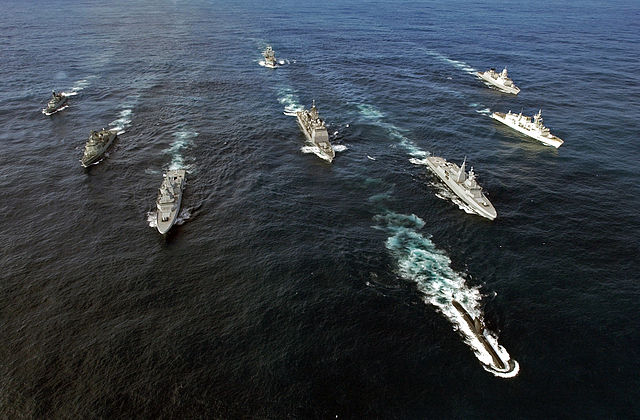
The SA Navy leading a multinational exercize
The initial enthusiasm for fast attack craft soon waned when their operational limitations were exposed by the demanding South Atlantic sea conditions. As early as 1981 it was predicted that locally-built corvettes would replace them, and this plan began to take formal shape in 1991. The submarine force was modernised, using local resources, but there was an acute need for two more hulls to ease the pressure on personnel. The French embargo on the Agosta class was even in fact a bigger blow than losing the two A 69s in 1978.
The end of the war in Angola, and Namibian independence led to severe cutting of defence budgets. Inevitably the SAN was severely affected, being forced to defer modernisation plans and to cut personnel. In 1995 total personnel stood at 5,034 total. The new ANC government was willing to support the armed forces’ requests for modernisation, but the weakened state of the economy threatens navy plans.
The post-cold war years and SAN Today
Despite austere cutbacks, the South African Navy led the way for the armed forces recovery and be welcome back in the international community, before even the elections of of 1994. The survey vessel SAS Protea in 1990 visited Europe, the first SAS vessel to do so since 1972. The same year, SAS Drakensberg and the Warrior-class Jan Smuts and Hendrik Mentz made a goodvill visit to Taiwan, a first for the South African Navy, never before sailing to the Far East, or at least since 1945.
Other international visits were made in Zaire, Kenya, Bangladesh, Turkey, France, Portugal, and Uruguay. In 1994 the “Rainbow nation” following the ANC victory was followed by an explosion of foreign warships and dignitaries visiting South African ports, even as far as Russia, Poland and Japan. That year alone, no less than 21 foreign vessels were present, from 8 countries, followed by 12 countries in 1995, ten countries in 1996. In 1997 the SAN celebrated its 75 birthday, with 15 countries participating.
The New Navy:
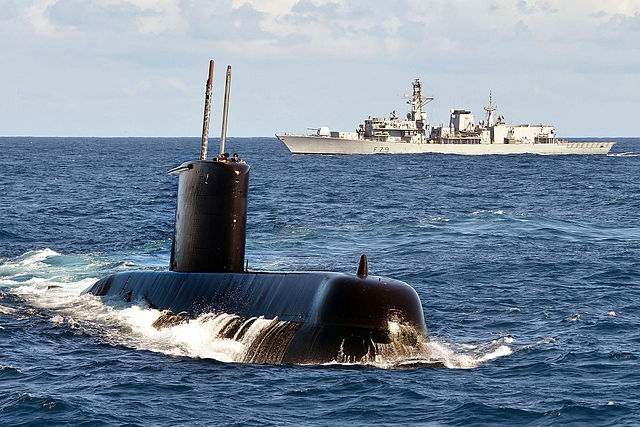
SAS Charlotte Maxeke with HMS Portland
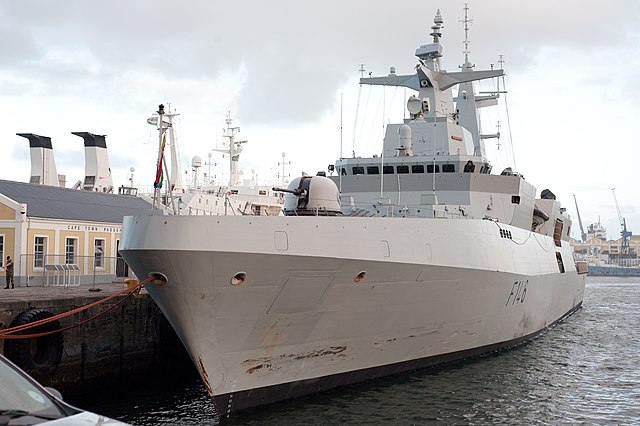
SAS Isandlwana (F146) on the Waterfront
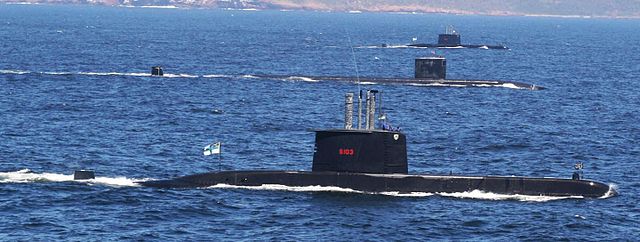
Type 209/1400 SAS Queen Modjadji underway with her sister ships
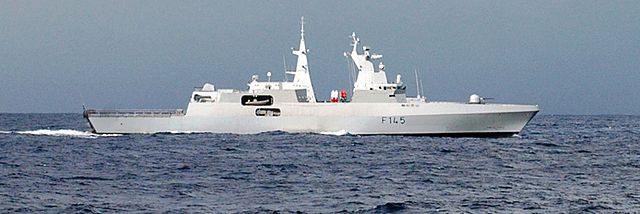
South African Navy frigate SAS Amatola (F145)
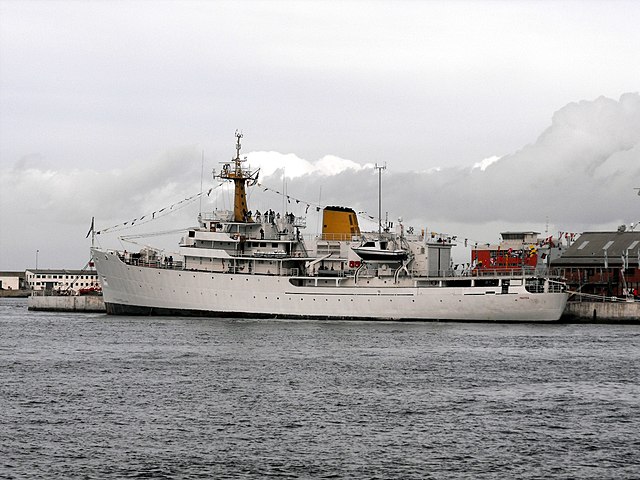
SAS Protea (1972)
The “Strategic Defence Package” in 1999 redefined the equipment of various arm branches, tainted by some “Arms Deal”, notorious acquisitions in the package marked by substantive allegations of corruption, fraud and bribery.A The package nevertheless was worth R30 billion, pledged to the purchase of new equipments for navy. The main objective was to leave its forced “brown-water” status, with ageing missile FACs and antiquated short-range diesel submarines, to a “green-water” combat integrated force planned for 2010.
In 2001 there was an initial request for five, later four vessels, of the German Meko A200SAN general purpose corvettes (designated frigates in South Africa), four British Super Lynx naval helicopters, three German Type 209/1400 diesel-powered submarines. From 1991, three locally T-Craft inshore patrol boats were also to be procured locally. Its future programs includes three Warror class IPV (Inshore Patrol Vessels) FY 2020/2024.
As of today, the SAN comprises the following:
- 3 Heroine class subs -Type 209/1400 (2005)
- 4 Valour class Frigates (Meko A200 Corvettes) (2004)
- 2 Warrior OPVs (former Saar FACs, 1979)
- 2 River class Minehunters/OPVs (1981)
- 3 T Class IPV (1992)
- 21 Namacurra class HPB (1981)
- SAS Drakensberg respenishment vessel (1987)
- SAS Protea survey vessel (1972)
- 6 Lima class LCUs (1990)
Read More
official site (no longer responds, archive)
Facebook Official
SA Navy Official Linkedin Page
South African Maritime Safety Authority
USNC Review by Deane Peter Baker
simonstown.com Naval Museum
sanho.co.za: South African National Hydrographic Office
sanavymuseum.co.za
defenceweb.co.za – SA Navy
On navypedia
Nomenclature of SANDF warships
 ‘Loch’ class Frigates (1944)
‘Loch’ class Frigates (1944)
HMSAS Good Hope, Natal, Transvaal
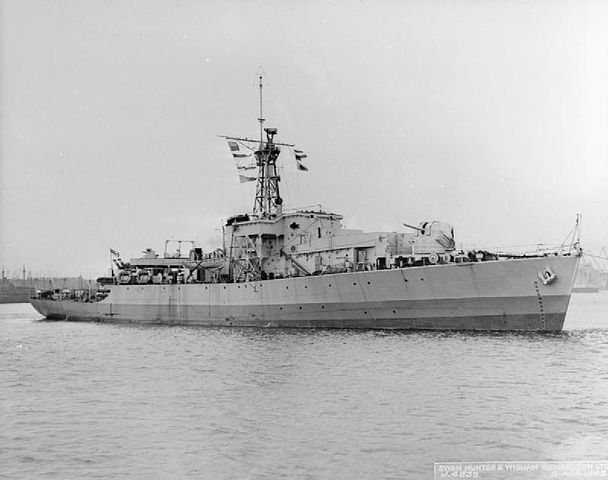
As the River class frigates in operation in 1943-44 were returned to the RN in 1946, three Loch-class Frigates, transferred in late 1944 and 1945 made the bulk of SANDF surface fleet. They were ex-Loch Boisdale, Loch Cree and Loch Ard. They displaced 1435 tonnes and their armament stayed unchanged until the 1960s. HMSAS Good Hope in 1955 became a dispatch vessel and training ship rearmed with a twin 4-in/45 Mark 16 DP guns forward, and Transvaal followed this in 1962 but with an extra extension of the forecastle to house the cadets. Good hope and Transvaal were scuttled in 1978 to create artificial reefs off False Bay, while Natal became a survey ship in 1957 and was sunk as target in 1976.
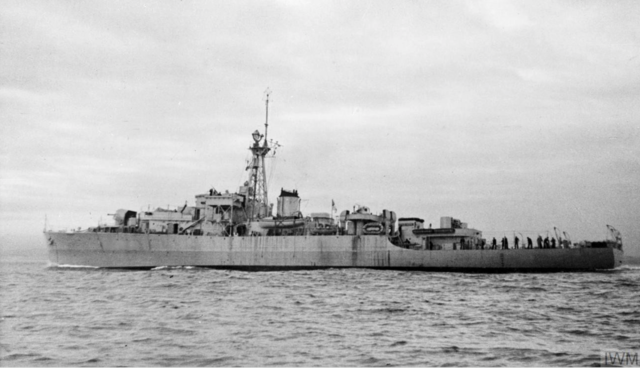
 Wager class Frigates (1950)
Wager class Frigates (1950)
HMSAS Jan Van Riebeeck, Simon Van der Stel.
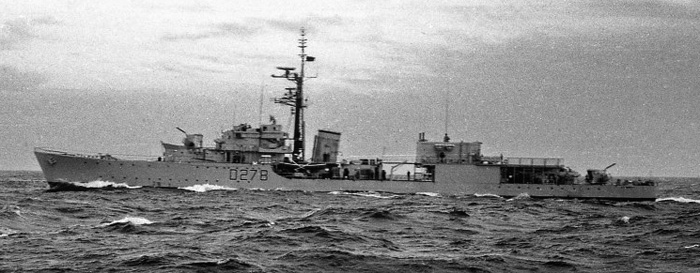
HMSAS Jan Van Riebeeck after conversion src shipspotting
Two “W” class destroyers transferred and acquired in 1950 and 1952 respectively. These destroyers, transferred from the RN, underwent modified Type 16 frigate conversions in 1962-66, their particulars being altered as follows: displacement 2105t standard, 2750t full load; draught (max) 17ft (5.2m); amament 4-4in/45 Mk 16 (2×2, in ‘B’ and Y’ positions), 4x 40mm 60 (4×1), 4-3pdr sauluting, 4-21in TT (1×4), two DCT, two DC racks, two Wasp ASW helicopters; complement 192. The 2l-in TT were removed c1972, and 6-12.75in Mk 32 ASW TT (2×3) added. JAN VAN RIEBEECK (D 278) was ex-Wessex, ex-Zenith. SIMON VAN DER STEL (from Hawthorn Leslie) was the ex-Whelp.
Riebeeck, sunk as a target in May 1980, was hit by a Skorpioen (Gabriel II) SSM from FAC fimFouche and subsequently torpedoed by submarine Maria van Riebeeck. Type 15 conversion by Harland & Wolff of former W” class destroyer,
purchased from the RN. Arrived Cape Town 19 February 1957. Two further Type 15 purchases (one was to have been HMS Roebuckk) were cancelled in 1956. Vrystaat was torpedoed in a submarine training exercise. See also on warinangola.com
 HMSAS Vrystaat (1956)
HMSAS Vrystaat (1956)
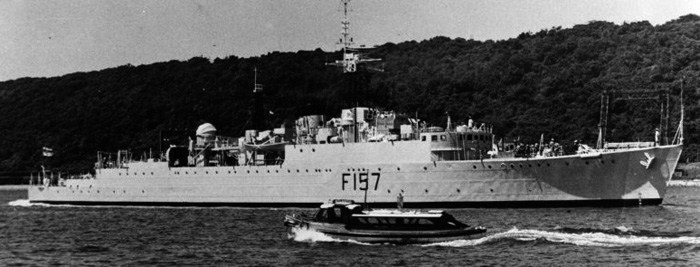
SAS Vrystaat in Durban, src: SA Naval Museum
A former W-class 1944 destroyer HMS Wrangler, converted as a Type 15 ASW Frigate, HMS Whirlwind F187, acquired 1956 by South Africa, renamed SAS Vrystaat (F157). She served until her loss in 1976. For more, see the Type 15 Frigates conversions.
 President class frigates (1956)
President class frigates (1956)
Pdt. Kruger, Pdt. Pretorius, Pdt. Steyn
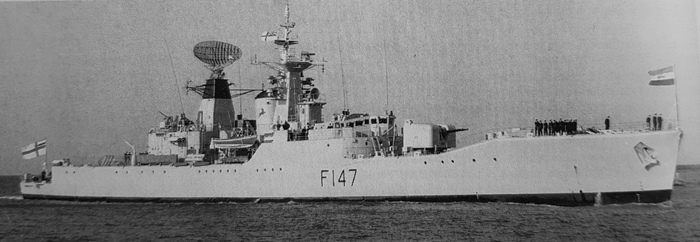
SAS President Steyn
Three ships ordered by South Africa and built in UK on the model of the Rothesay class. They were launched in 1960-61 and completed in 1962-64. As built, almost identical with the RN Rothesay class, although having a twin
40mm Mk 5 at main deck level in place of the STAAG Mk 2. All three refitted at Simonstown (President Pretorius, 1968-70, President Steyn, 1969-71, President Kruger, 1971-77) with a plated foremast, French Jupiter surveillance radar on a new plated mainmast, and Italian Elsag NA9C fire control in place of the Mk 6M director (the latter not in President Kruger until 1979).
A small hangar for a Wasp helicopter added abaft the mainmast, with 2-40mm/60 singles on top, and the forward Limbo well was plated over to form a flight deck. Six 12.75in Mk 32 ASW TT (2×3) were added c1972. President Kruger was given a modified funnel cap to carry smoke clear of the foremost radar arrays c1975. President Steyn was decommissioned in August 1980 to be cannibalised for her sisters. The two survivors were laid up at Simonstown for some years stripped of armament and sensors, President Kruger was lost 80 miles southwest of the Cape on 18 February 1982 with thirteen of her crew in a night collision with the replenishment ship Tafelberg (A 243).

 A69 class corvettes (1978): Never delivered.
A69 class corvettes (1978): Never delivered.
Good Hope, Transvaal
Ordered from France as A69 class corvettes to replace the WW2 Loch class frigates of the same name. Replacements for the old ‘Loch’ class frigates with the same names ordered from France in 1976, two A69 units building for the French Navy being made available. Differed slightly from standard French design, having USN-pattern Mk 32 triple ASW TT on the quarterdeck. In September 1978, when both ships were almost ready, France cancelled the contract, because of the UN arms embargo on South Africa. Sold to Argentina on 25 September 1978 and renamed ARA Drummond and Guerrico respectively.
 Daphne class submersibles (1969)
Daphne class submersibles (1969)
Maria van Riebeeck, Emily Hobhouse, Johanna van der Merwe
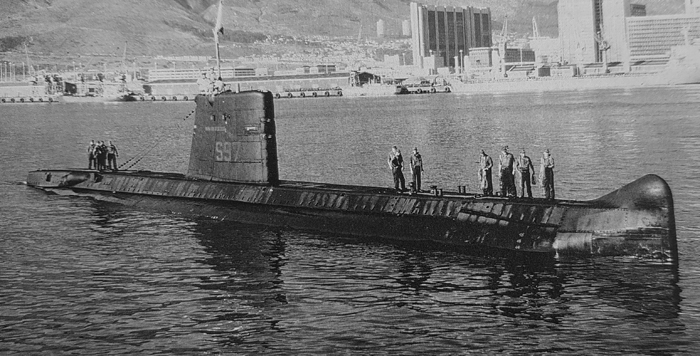
Three Daphne-type conventional attack submarines built in Lorient in 1968-71.
In 1976, two more subs, this time of the more modern Agosta type were ordered in AC Dubigeon. France however cancelled the contract in 1978 due to international pressures about the Apartheid policy. They would have been named HMSAS Astrant and Adventurous. F 432 GOOD HOPE (ex-Lieutenant de Vaisseau Le Hénaff) and F 102 TRANSVAAL (ex-Commandant l’Herminier).
During the 1980s strenuous efforts were made to find replacements for the President class, including clandestine construction or purchase, in defiance of the UN embargo. Currently plans are for four light frigates displacing about 1500t, and armed with a 76mm gun, electronics and Light frigates/Offshore Skerpioen missiles to be armed from stricken Minister class to Yarrow Shipbuilders in the UI EN Bazán in Spain turned short in November 1994.
 Minister class Strike Craft (1977)
Minister class Strike Craft (1977)
Jan Smuts, P W Botha, F. Creswell, Jim Fouché, F. Erasmus, Oswlad Pirow, Hendrik Mentz, Kobie Coeztee, Magnus Malan.
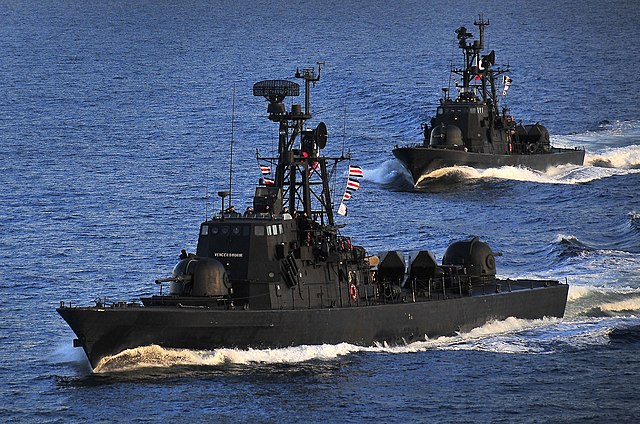
These ships were ordered to Israel, the first three built in Haifa in late 1974 while heavy equipments was bring by ARMSCOR. They were modified Reshef-class FACs. Due to the international embargo on arms sale from 4 November 1977, very tight security was held for the delivery of the “scorpion” (Gabriel) missiles, and two Oto Melara 76 mm guns instead of the planned Phalanx CIWS. The squadron was under command of Glen Syndercombe, and renamed SAS Scorpion in 1980 befre being split into two squadrons in 1985 based in Simonstown.
After 1990, three decommissioned Warrior-class were refurbished locally, recommissioned as offshore patrol vessels (OPVs) in 2012 to 2014. The missile launchers were removed, a small RHIB boat installed, plus a small contingent of seaborne commandos for boarding Ops. They kept their rear OTO Melara 76 mm, two Oerlikon 20 mm guns, two Browning 12.7 mm HMGs. They were recommissioned as SAS Isaac Dyobha (P1565), SAS Galeshewe (P1567) and SAS Makhanda (P1569), based in Durban. Rear Admiral Hanno Teuteberg in 2013 wanted them prolongated until Project Biro (New OPVs) was operational. As of today the others were decommissioned in 2004-2008, but SAS Galeshewe is in reserve, leaving two active OPVs.
Quikspecs (1980): 415/450 tons FL, 58 m (190 ft) x 7.62 m (25.0 ft) x 2.4 m (7.9 ft) powered by 4 MTU 16V 538 diesel engines 12,800 hp (9,500 kW), 34 knots (63 km/h; 39 mph), range 4,000 nmi (7,400 km; 4,600 mi) at 17.5 knots. Crew 45, Radars Elta EL/M-2207/2208, Selenia Orion RTN-10X FCS, chaff rocket launchers, armed with 4 × Gabriel II SSMs, 2 × OTO Melara 76 mm naval guns, 2 × Oerlikon 20 mm cannons.
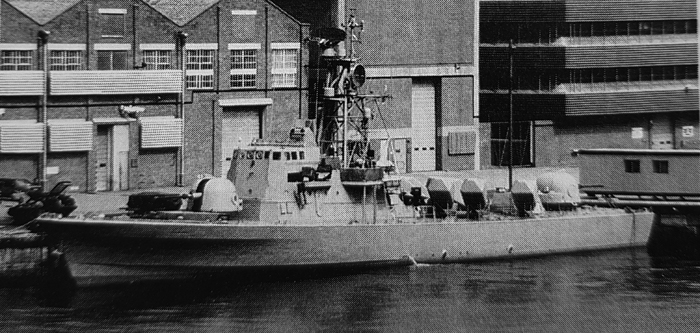
 ‘Ford’ class seaward defence boats (1954)
‘Ford’ class seaward defence boats (1954)
Gelderland, Nautilus, Rijger, Haarlem, Oosterland
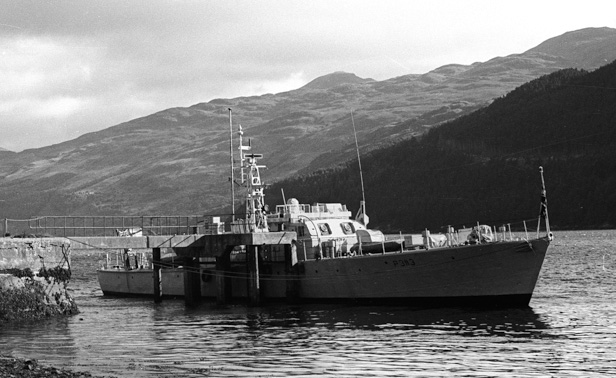
These British-built vessels were ‘Ford’ class seaward defence boats of 1950, two were transferred from RN and three were built in UK for South African Navy. These were the Gelderland (ex-Brayford) P3105 from Inglis, Glasgow, UK laid down 1951, launched 19.2.1954 and comp. 8.1954, stricken 12.1988, Nautilus (ex-Glassford) P3120 from Dunston, Thorne (28.3.1955), sold 1989, Rijger from Vosper, Portsmouth (6.2.1958/10.1958), sunk as target in 1989, Haarlem ot P3126 from Vosper, Portsmouth, (18.6.1958/6.1959), scuttled on 30.11.1987 during the border war and Oosterland (P3127) also from Vosper, Portsmouth (27.1.1959/9.1959) sunk as target in 1989.
Specs: Displacement 120/160 t FL, 33.5 pp/35.7 oa x 6.10 x 1.50m. Powered by 2x 12-cyl Paxman diesels + 1 Foden diesel, 3 shafts 1100 + 100 hp, 18/8 kts. Fuel: diesel oil 23 tons. They were armed with a single 40mm/60 Mk 7, Bofors, 2 DCT, 2 DCR and a navigation and surface radar type 978 and type 144 sonar. Crew 19. See photos.
 Algarine class minesweepers (1947)
Algarine class minesweepers (1947)
Bloemfontein, Pietermaritzburg
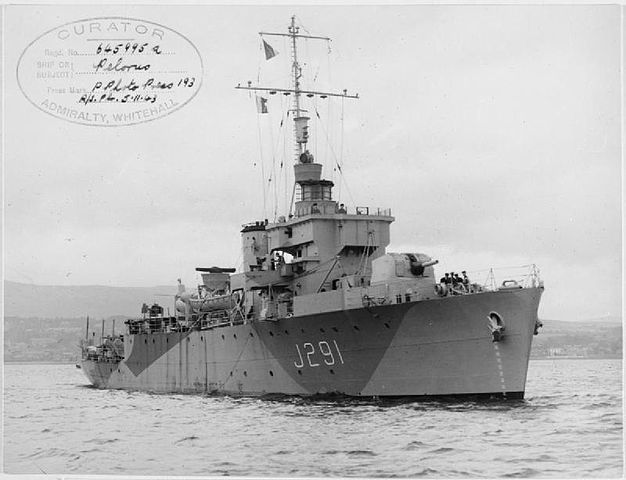
These two WW2 Algerine class vessels were built in Canada and UK respectively: SAS Bloemfontein (ex-Rosamund) was J439, then M439 (built in Port Arthur, Collingwood Shipyards Ltd. Canada), laid down 4.1944, launched 20.12.1944, comp. 7.1945 and transferred 9.1947. She was sunk as target 6.1967. SAS Pietermaritzburg (ex-Pelorus) J291, then M291 was built in Lobnitz, Renfrew, UK laid down 10/1942, launched 18.6.1943 comp. 10.1943 and transferred in 1947. She became a TS from 8.1962 and was hulked in 1976.
Quickspecs: 1030/1325 tons FL, 68.6 x 10.8 x 3.28 m DL, 2 shafts VTE, 2 Admiralty 3-drum boilers, 2400 shp, 16.5 kts, 230-239 tons oil for 6000 nm/12kts. They were armed with a single 102mm/45 QF Mk V, four twin 20mm/70 Oerlikon Mk II/IV AA guns, 4 DCT, 2 DCR (90 – 92 in ASW role) and fitted with mechanical, magnetic, and acoustic minesweeping gear. They also carried modern type 291 and type 272 radars, and type 128 sonar. Crew 138.
 ‘Ton’ class minesweepers (1955)
‘Ton’ class minesweepers (1955)
Johannesburg, Kimberley, Port Elizabeth, Mosselbaai, Walvisbaai, East London, Windhoek, Durban, Kaapstad, Pretoria
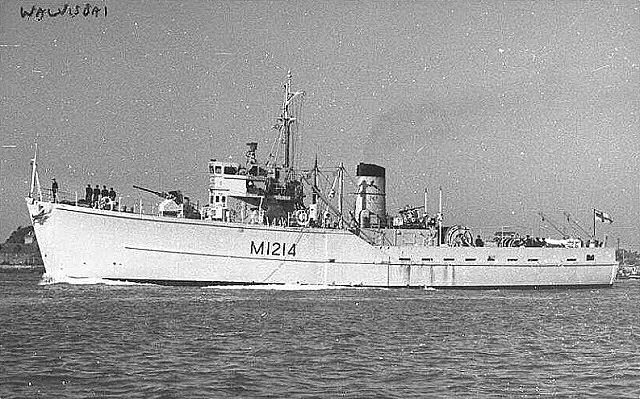
SAS Walvisbaai (src superyachttimes.com)
Nine “Ton” class vessels. No specs different than the British type. They were laid down in 1956, launched 1954-57, transferred to South Africa 1958-59. Some were discarded in 1988, one in 1989, one convrted as a museum ship in 1987 and the others discarded 2001-2002. They participated in the 1980s border war. Photo SAS Durban as a museum ship, Port Natal Maritime Museum.
 River class inshore MWV/OPVs (1986)
River class inshore MWV/OPVs (1986)
SAS Umkomaas, Umgeni, Umzimkulu, Umhloti
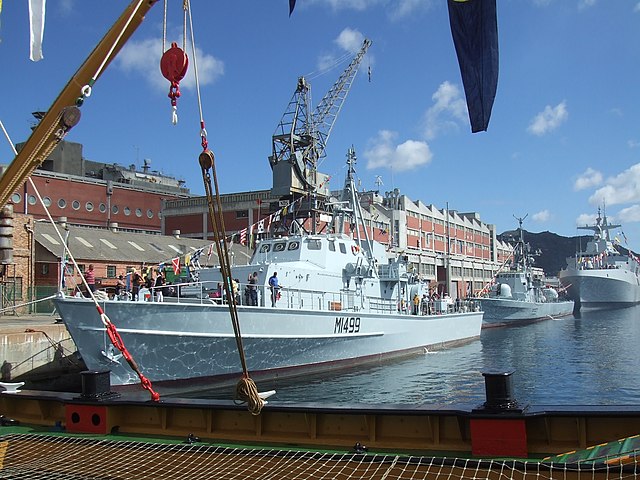
The River class is a class of four minehunters built for the South African Navy by Abeking & Rasmussen, completed (and armed) at Sandock-Austral, ordered as research vessels to passe the Embargo. They have a secondary role as Inshore Patrol Vessels. They were commissioned as M1499-1213, 1142 and 1212 between January and December 1981.
Quickspecs: 390 t, 48 x 8.5 x 2.5 m (157.5 x 27.9 x 8.2 ft), propelled by two MTU 12V TB81 diesels, 2 shaft 3,367 kW (4,515 hp), top speed 16 knots (30 km/h; 18 mph), range 2,000 nmi (3,700 km; 2,300 mi)/13 knots (24 km/h; 15 mph), crew 40, armed with a single Oerlikon 20 mm cannon, two Browning M2HB 12.7 HMGs.
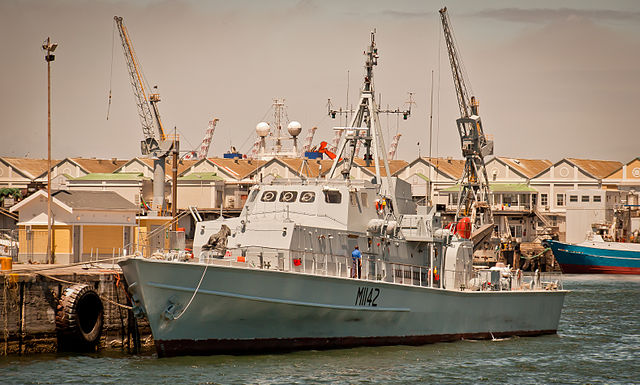
 Namacurra class HPBs (1981)
Namacurra class HPBs (1981)
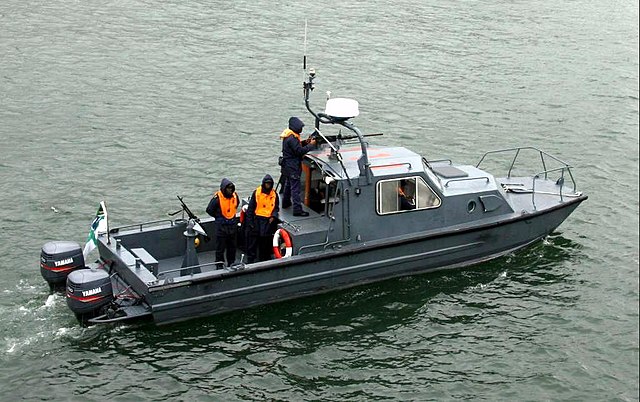
Built in South Africa between 1980-81, road transportable if needed. One was indeed transferred to Malawi in October 1988, two to Namibia in 2002, two to Mozambique (September 2004) and Y1506 was lost at sean off Port Elizabeth. They were part of the harbour patrol forces in Cape Town, Port Elizabeth, Durban and Walvis Bay. Also part of the Operational Boat Squadron until replacement. Some exported.
Quickspecs: 4t normal/5.2t max, 9.5 x 2.5 m, Propulsion 2 x 140Kw BMW marine petrol engines, 32 knots, crew 5, Racal Decca; I-band radars, armed with a single 12.7 mm Browning HMG, 2×7.62mm LMG, scare charges and snag-lines, 12gg shotgun, R4 assault rifles. 28 boats in inventory in 2008.
 SAS Drakensberg (1986)
SAS Drakensberg (1986)
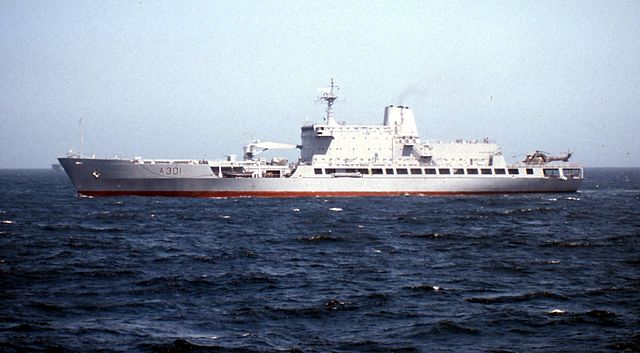
Built in Durban, the ship was reassessing the issues with the previous SAS Tafelberg. It was designed to carry 5,500 tons of diesel fuel, 210 tons of fresh water, 100 tons of dry provisions, 30 tons of frozen food, 230 tons of containerized cargo, and up to 1,000 tons of palletized cargo. Offloading used a 20-ton crane, four 2-ton cranes, a 5-ton hoist, two lifts.
Replenishment at sea was made from two abeam positions of the deck astern. The ship also had its on-board plant to produce 50,000 litres (11,000 imp gal; 13,000 US gal) of fresh water from sea water daily.
She also carried inflatable boats (RHIB) ‘Stingrays’ and two Delta-80 LCUs. Armament of the 147 m, 12,500 tons fully loaded vessel, powered by two 6,600 kW B&W V12 engines (single variable-pitch propeller+ Bow thrusters), to 21+ knots, 8000 nm, was limted to 4x 20 mm Oerlikon cannons and six Broning 12.7 mm M2HB for self defense. She was also given an helispot aft and hangar for two Atlas Oryx helicopters.
Quickspecs: 6,000 tons light, 12,500 tons FL, 147 x 19.5 x 7.9 m (482 x 64 x 25.9 ft). Powered by two 6600 kW B&W V12 engines, single propeller, bow thruster. 21 knots, 8,000 nm (15,000 km)/15 kts, crew 115. Armament/requipments: see notes.


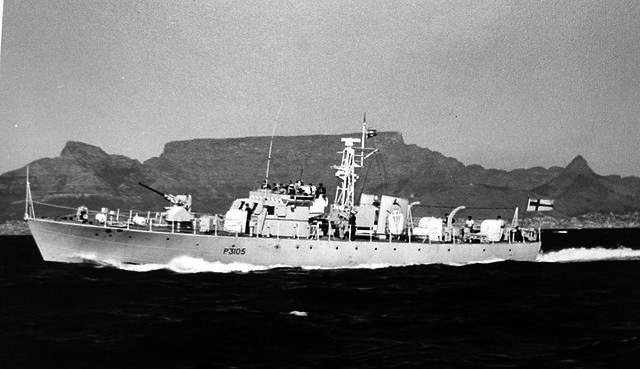
 Latest Facebook Entry -
Latest Facebook Entry -  X(Tweeter) Naval Encyclopedia's deck archive
X(Tweeter) Naval Encyclopedia's deck archive Instagram (@navalencyc)
Instagram (@navalencyc)





 Austrian Navy
Austrian Navy French Navy
French Navy Royal Navy
Royal Navy Armada Espanola
Armada Espanola K.u.K. Kriegsmarine
K.u.K. Kriegsmarine Dansk Marine
Dansk Marine Nautiko Hellenon
Nautiko Hellenon Koninklije Marine 1870
Koninklije Marine 1870 Marinha do Brasil
Marinha do Brasil Osmanlı Donanması
Osmanlı Donanması Marina Do Peru
Marina Do Peru Marinha do Portugal
Marinha do Portugal Regia Marina 1870
Regia Marina 1870 Nihhon Kaigun 1870
Nihhon Kaigun 1870 Preußische Marine 1870
Preußische Marine 1870 Russkiy Flot 1870
Russkiy Flot 1870 Svenska marinen
Svenska marinen Søværnet
Søværnet Union Navy
Union Navy Confederate Navy
Confederate Navy Armada de Argentina
Armada de Argentina Imperial Chinese Navy
Imperial Chinese Navy Marinha do Portugal
Marinha do Portugal Mexico
Mexico Kaiserliche Marine
Kaiserliche Marine 1898 US Navy
1898 US Navy Russkiy Flot
Russkiy Flot French Naval Aviation
French Naval Aviation Russian Naval Aviation
Russian Naval Aviation Sovietskiy Flot
Sovietskiy Flot Royal Canadian Navy
Royal Canadian Navy Royal Australian Navy
Royal Australian Navy RNZN Fleet
RNZN Fleet Chinese Navy 1937
Chinese Navy 1937 Kriegsmarine
Kriegsmarine Chilean Navy
Chilean Navy Danish Navy
Danish Navy Finnish Navy
Finnish Navy Hellenic Navy
Hellenic Navy Polish Navy
Polish Navy Romanian Navy
Romanian Navy Turkish Navy
Turkish Navy Royal Yugoslav Navy
Royal Yugoslav Navy Royal Thai Navy
Royal Thai Navy Minor Navies
Minor Navies Albania
Albania Austria
Austria Belgium
Belgium Columbia
Columbia Costa Rica
Costa Rica Cuba
Cuba Czechoslovakia
Czechoslovakia Dominican Republic
Dominican Republic Haiti
Haiti Hungary
Hungary Honduras
Honduras Estonia
Estonia Iceland
Iceland Eire
Eire Equador
Equador Iran
Iran Iraq
Iraq Latvia
Latvia Liberia
Liberia Lithuania
Lithuania Mandchukuo
Mandchukuo Morocco
Morocco Nicaragua
Nicaragua Persia
Persia San Salvador
San Salvador Sarawak
Sarawak Uruguay
Uruguay Venezuela
Venezuela Zanzibar
Zanzibar Warsaw Pact Navies
Warsaw Pact Navies Bulgaria
Bulgaria Hungary
Hungary

 Bundesmarine
Bundesmarine Dutch Navy
Dutch Navy Hellenic Navy
Hellenic Navy Marina Militare
Marina Militare Taiwanese Navy
Taiwanese Navy Chinese Navy
Chinese Navy Indian Navy
Indian Navy Indonesian Navy
Indonesian Navy JMSDF
JMSDF North Korean Navy
North Korean Navy Philippines Navy
Philippines Navy ROKN
ROKN IDF Navy
IDF Navy Royal New Zealand Navy
Royal New Zealand Navy Egyptian Navy
Egyptian Navy South African Navy
South African Navy

































 RN
RN
 Marine Nationale
Marine Nationale
 Soviet Navy
Soviet Navy
 dbodesign
dbodesign